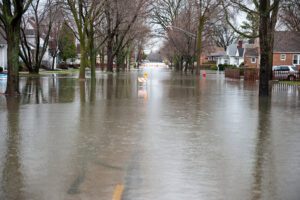Spring flood damage and tips on flood loss avoidance

While there is no specific flood season, flooding and flood damage usually occurs in the U.S. from spring to fall. It is also more likely to occur in areas with seasonal rainstorms or spring snowmelt. Be sure to follow the weather channel or your local news source to keep up to date about predictions in your area.
What causes spring floods and flood damage
The warming temperatures and spring rains cause snow and ice to melt rapidly, making it harder for the thawing ground to absorb rainfall. Since the water has nowhere to go, it runs off into lakes, streams, and rivers, which can cause them to overflow and flood basements, roadways, businesses, and even homes.
Another contribution to Spring floods is ice jams or ice dams. These occur when floating river ice collects in an area and blocks the progress of the ice downstream. Ice jams can slow the flow of a river and cause upstream flooding. They can even cause flash floods if the jam is suddenly released.
Who needs to be ready for a flood?
Everyone. Whether you rent, own a home, or business, you could be at risk for a flood. Even if you have insurance to cover your home or business, they usually do not cover floods. It’s up to you to make sure you’re covered if flood damage occurs. Checking a flood map will help you understand your risk and can empower you to take steps and reduce flood damage.
How can fires increase your chance of a flood?
Did you know properties affected by fires are at risk for flooding? Scorched soil cannot absorb water; it forms a water-repellent layer and can block water absorption for up to 5 years. This means even a light rain could turn into a flood.
Before a flood
If your area has received a flood warning or flooding has been forecast, you can take measures to help minimize flood damage and losses. The good news is that your National Flood Insurance Program (NFIP) flood policy offers flood loss avoidance and will cover up to $1,000 in reasonable expenses to protect your insured property. It will also cover up to $1,000 to move your insured property away from a flood or imminent flood danger. What is eligible?
Sandbags, including the sand to fill themFill to create temporary leveesWater pumpsPlastic sheeting and lumberBoxes and packaging materialsMoving, transportation, or shipping costsLabor, including your own or a family member’s labor, at the federal minimum wage. Labor charged by a professional may also be reimbursed.Note: The moved personal property must be placed in a fully enclosed building or otherwise protected from the elements.
If you have any questions, contact your agent BEFORE a flood has been forecast. Make sure you understand your coverage and take the proper steps to prepare.
Flood Restoration After a flood
It’s important to be safe! Only return to your home after authorities say it’s safe. Be sure to take pictures and document any damage caused by the flood before you start to clean up. You can take some steps to begin clean-up after a flood; however, you may need to call professionals to help with flood restoration.
Wear heavy work gloves, protective clothing, and boots during clean-up. Use appropriate face coverings or masks to clean mold or other debris. People with asthma and other lung conditions and/or immune suppression should not enter buildings with indoor water leaks or mold growth that can be seen or smelled. Children should not take part in disaster clean-up work.Be aware that snakes and other animals may be in your house.Be aware of the risk of electrocution. Do not touch electrical equipment if it is wet or if you are standing in water. Turn off the electricity to prevent electric shock if it is safe.Avoid wading in floodwater, which can be contaminated and contain dangerous debris. Underground or downed power lines can also electrically charge the water.Use a generator or other gasoline-powered machinery ONLY outdoors and away from windows.
Bankers also provides an active storm tracker with steps and resources on how to prepare for a flood. Feel free to bookmark the page in your browser for easy access.
Learn more about flood insurance
Flooding can happen in any state and is the most common natural disaster. We want to ensure you have as many resources as possible so you’re prepared when it matters. In our blog on how to protect yourself from unexpected damage, we go into detail about what an NFIP policy is and how much FEMA offers if you do experience flood damage. If you have any questions, don’t hesitate to contact us to request a quote or speak to an agent. We’re happy to guide you through the process.




